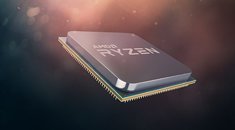- Joined
- Oct 9, 2007
- Messages
- 47,527 (7.48/day)
- Location
- Hyderabad, India
| System Name | RBMK-1000 |
|---|---|
| Processor | AMD Ryzen 7 5700G |
| Motherboard | ASUS ROG Strix B450-E Gaming |
| Cooling | DeepCool Gammax L240 V2 |
| Memory | 2x 8GB G.Skill Sniper X |
| Video Card(s) | Palit GeForce RTX 2080 SUPER GameRock |
| Storage | Western Digital Black NVMe 512GB |
| Display(s) | BenQ 1440p 60 Hz 27-inch |
| Case | Corsair Carbide 100R |
| Audio Device(s) | ASUS SupremeFX S1220A |
| Power Supply | Cooler Master MWE Gold 650W |
| Mouse | ASUS ROG Strix Impact |
| Keyboard | Gamdias Hermes E2 |
| Software | Windows 11 Pro |
AMD today launched its first desktop Ryzen "Raven Ridge" APUs that combine quad-core "Zen" CPUs with "Vega" based integrated graphics solutions. One of its key specifications that caught our eye is its PCI-Express interface. Apparently, these chips feature just 8 PCI-Express gen 3.0 lanes for discrete graphics, besides 4 lanes dedicated as the chipset-bus, and 4 other lanes driving a 32 Gbps M.2 NVMe slot. What this means for the end-users, is that any discrete graphics cards plugged into the PCI-Express 3.0 x16 slot will run at half the bandwidth - PCI-Express 3.0 x8.
Our various PCI-Express scaling articles, which we regularly redo with the latest high-end GPUs, should tell you that the performance loss between gen 3.0 x16 and gen 3.0 x8 is negligible. This, however, becomes a problem for the small minority of users who combine these processors with AMD X370 chipset motherboards. The second x16 slot (which draws its PCIe lanes by segmenting it from the first x16 slot) won't work, and without at least x8 bandwidth, there's no possibility of NVIDIA SLI functioning, even on X370 motherboards that have SLI certification. One can't even argue that some internal PCIe lane allocation to the iGPU permanently locks 8 lanes away from PEG. AMD confirms that the "Zen" CCX and the "Vega 11" iGPU talk to each other over Infinity Fabric, not PCIe.

AMD responded to our story in advance with this statement:
View at TechPowerUp Main Site
Our various PCI-Express scaling articles, which we regularly redo with the latest high-end GPUs, should tell you that the performance loss between gen 3.0 x16 and gen 3.0 x8 is negligible. This, however, becomes a problem for the small minority of users who combine these processors with AMD X370 chipset motherboards. The second x16 slot (which draws its PCIe lanes by segmenting it from the first x16 slot) won't work, and without at least x8 bandwidth, there's no possibility of NVIDIA SLI functioning, even on X370 motherboards that have SLI certification. One can't even argue that some internal PCIe lane allocation to the iGPU permanently locks 8 lanes away from PEG. AMD confirms that the "Zen" CCX and the "Vega 11" iGPU talk to each other over Infinity Fabric, not PCIe.

AMD responded to our story in advance with this statement:
The target market for Raven Ridge, PC builders or DIYers who value the presence of SoC graphics, will select B350 or A320 motherboards, which do not feature the ability to split PCIe lanes. X370 buyers are typically buying the high end Ryzen, such as Ryzen 5 6-core and Ryzen 7 8-core, to go with that class and price motherboard. For the majority of the market, upgrading from the class leading processor graphics inside the Ryzen 5 2400G or Ryzen 3 2200G to a single discrete GPU will be more than enough, given then performance on offer today from discrete graphics cards such as Radeon RX VEGA64 and Radeon RX 580. And today, those buyers can select from our 1st Gen Ryzen desktop processors, including the Ryzen 5 1500X and Ryzen 3 1300X which remain in the product stack for those buyers who value the extra PCIe lanes.
Additionally, we typically expect buyers who want to run mGPU are doing so from day one. These consumers are finding the lure of the of the Threadripper platform very compelling - massive performance, class leading PCIe lanes, and massive memory bandwith are all the perfect complementary features to go with multi-GPU compute, and gaming.
Raven Ridge was created for the ultra thin and light performance notebook segment, but also to scale into the mainstream performance desktop. It does this through the scalability of "Zen" and "Vega" IP, connected by AMDs Infinity Fabric, offering outstanding graphics performance and features for the price point in the desktop market. The scalable nature of the Socket AM4 platform means that there is a path for users to begin with an entry level motherboard and mainstream processor, and now upgrade processor and platform features the same way that people upgrade discrete graphics card.
View at TechPowerUp Main Site


